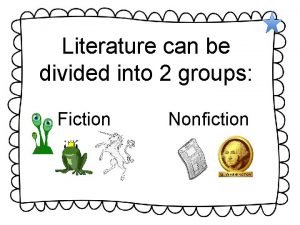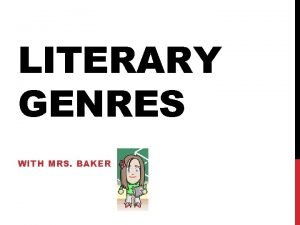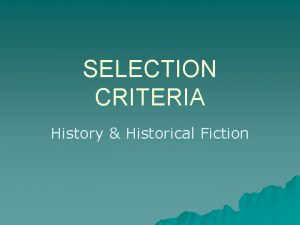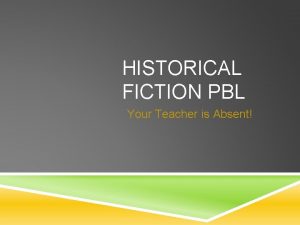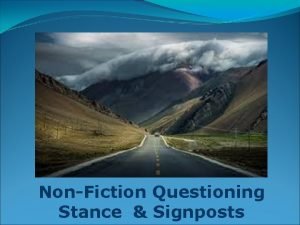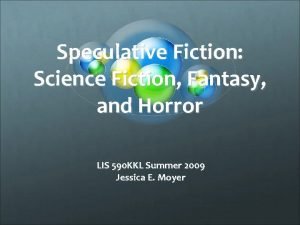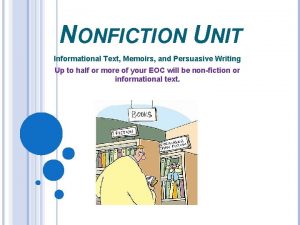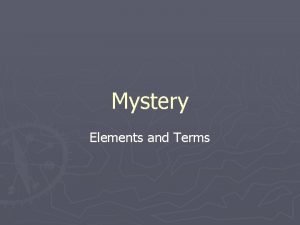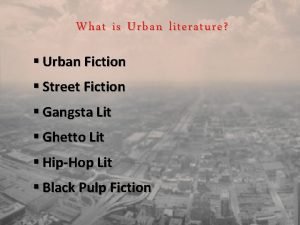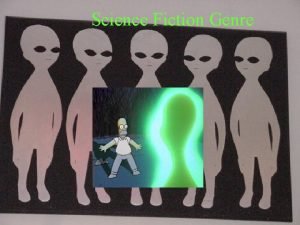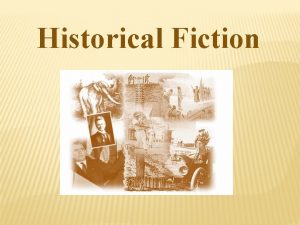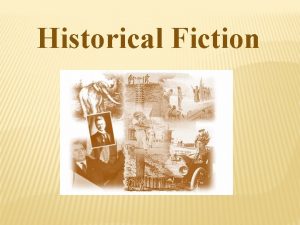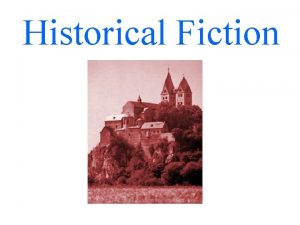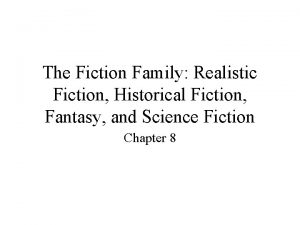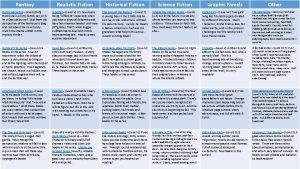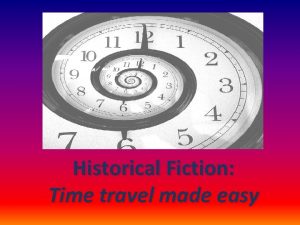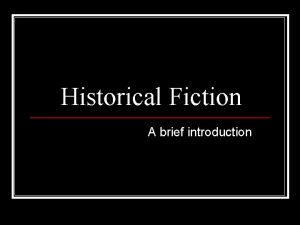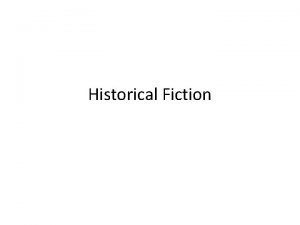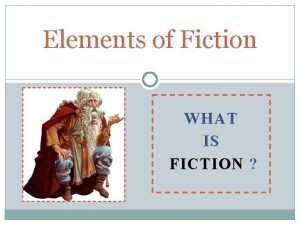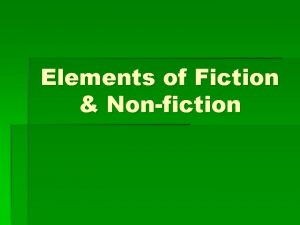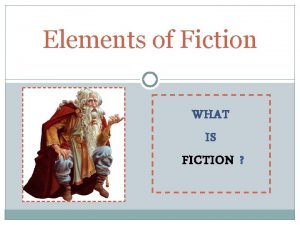Historical Fiction What is historical fiction What are

















- Slides: 17

Historical Fiction -What is historical fiction? -What are some examples? (Movies, books, TV shows)


Setting Place refers to a particular geographical location • I stepped off of the train and suddenly I was surrounded by skyscrapers; mammoth concrete structures that seemed to block out the sky with their rigid infinite lines. • The battlefield was littered with debris, blood, gun shells, and wounded men begging for help. Time refers to a particular historical period • The trembling servant placed the papyrus scroll in front of the Pharaoh. • Sophie jumped with joy when she received the telegram. “Let us take the carriage to Lady Windsor’s tea party!”

“It doesn’t matter who you marry, as long as he thinks like you and is a gentleman and a Southerner and prideful. For a woman, love comes after marriage. ” “Oh, Pa, that’s such an Old Country notion!” “And a good notion it is! All this American business of running around marrying for love, live servants, like Yankees! The best marriages are when the parents choose for the girl. For how can a silly piece like yourself tell a good man from a scoundrel? ” Gone With the Wind

“Before us the narrow, sun-splotched road wound like a lazy red serpent dividing the high forest bank of quiet, old trees on the left from the cotton field, forested by giant green and purple stalks, on the right. A barbed-wire fence ran the length of the deep field, stretching eastward for over a quarter of a mile until it met the sloping green pasture that signaled the end of our family’s four hundred acres. An ancient oak tree on the slope, visible even now, was the official dividing mark between Logan land the beginning of a dense forest. Beyond the protective fencing of the forest, vast farming fields, worked by a multitude of sharecropping families, covered two thirds of a ten-square-mile plantation. That was Harlan Granger land. Once our land had been Granger land too, but the Grangers had sold it during Reconstruction to a Yankee for tax money. In 1887, when the land was up for sell again, Grandpa had bought two hundred acres of it, and in 1918, after the first two hundred acres had been paid off, he had bought another two hundred. It was good rich land, much of it still virgin forest, and there was no debt on half of it. But there was a mortgage on the two hundred acres bought in 1918 and there were taxes on the full four hundred, and for the past three years there had not been enough money from the cotton to pay both and live on too. ” Roll of Thunder, Hear My Cry pg. 6

Plot • Must be plausible (believable) • Usually the story’s problem or puzzling event is a result of the time or an event in history • Reader/listener usually feels that the story really happened or could have happened

“…But there was a mortgage on the two hundred acres bought in 1918 and there were taxes on the full four hundred, and for the past three years there had not been enough money from the cotton to pay both and live on too. ” That was why Papa had gone to work on the railroad. In 1930 the price of cotton dropped. And so, in the spring of 1931, Pap set out looking for work, going as far north as Memphis and as far south as the Delta country. He had gone west too, into Louisiana. It was there he found work laying track for the railroad. He worked the remainder of the year away from us, not returning until the deep winter when the ground was cold and barren. The following spring after the panting was finished, he did the same. Now it was 1933, and Papa was again in Louisiana laying track. I asked him once why he had to go away, why the land was so important. He took my hand said in his quiet way: ‘Look over there, Cassie girl. All that belongs to you. You ain’t never had to live on nobody’s place but your own and long as I live and the family survives, you’ll never have to. That’s important. You may not understand that now, but one day you will. Then you’ll see. ’” Roll of Thunder Hear My Cry, pg. 7

Theme • Theme: Main idea or underlying meaning of a literary work that may be stated directly or indirectly • Themes usually fit within a historical context or can have conflicting contexts between historically different views • Themes are related to life, people, social, political events as well as good versus bad/evil. • EX: Love, friendship, war, revenge, crime, punishment

Theme Examples • The theme in a story is its underlining message, or ‘big idea. ’ This belief, or idea, transcends cultural barriers. It is usually universal in nature. When a theme is universal, it touches on the human experience, regardless of race or language. • Name theme of the literary work. Some have more than one theme: • • • Romeo and Juliet Gone with the Wind Charlotte’s Web Harry Potter Bud, Not Buddy Encounter

Characterization • Characters are ordinary or real people who lived or could have lived in the historical setting • Actions and choices are shaped by the setting • Characters usually change/grow as they encounter problems • Dialogue is reflective of the setting (time period/environment) • Characters usually have easily identifiable dominant traits

“Christopher-John, walking between Stacey and me, glanced uneasily at both of us but did not interfere. A short, round boy of seven, he took little interest in troublesome things, preferring to remain on good terms with everyone. Yet he was always sensitive to others and now, shifting the handle of his lunch can from his right hand to his left armpit, he stuffed his free hands into his pockets and attempted to make his face as moody as Stacey’s and as cranky as mine. But after a few moments he seemed to forget that he was supposed to be grouchy and began whistling cheerfully. There was little that could make Christopher-John unhappy for long, not even the thought of school. ” Roll of Thunder, Hear My Cry pg. 5

Characterization is the way in which authors convey information about their characters. Characterization can be direct, as when an author tells readers what a character is like (e. g. "George was cunning and greedy. ") or indirect, as when an author shows what a character is like by portraying his or her actions, speech, or thoughts (eg. "On the crowded subway, George slipped his hand into the man's coat pocket and withdrew the wallet, undetected. "). Descriptions of a character's appearance, behavior, interests, way of speaking, and other mannerisms are all part of characterization. For stories written in the first-person point of view, the narrator's voice, or way of telling the story, is essential to his or her characterization.

Style • Literary element that describes the ways that the author uses words- author’s word choice, sentence structure, figurative language, and sentence arrangement all work together to establish mood, imagery, and meaning in a text • EX: poetic, descriptive, factual • Author usually uses foreshadowing or clues to tease the reader/listener’s curiosity • Some events include historical events, dialogue, period thoughts (current events of the time); Major events are usually historically accurate, but not all information is authentic(true). Characters and dialogue need to fit historical aspects • Dialogue, artifacts and feelings are contemporary and accurate enough to reach a wide audience

Tone • Tone is the author’s attitude toward the topic. This attitude is expressed through the words and details he or she selects. Tone and mood can vary across the wide range of historical fiction time periods and stories. The author’s tone is more about the emotional affect of reading historical fiction, of connecting to the past through narrative • Readers want to feel that the story really happened. The reader/listener feels he or she experienced the historical setting and situation

Ambivalent- undecided, unsure Amused- entertained Critical- disapproving Incredulous- doubtful Objective- factual (textbook) Reverent- respectful Sympatheticunderstanding Serious- earnest, solemn Formal- stiff, factual Optimistic- positive, believing in positive outcomes

Dialogue • http: //www. readwritethink. org/files/resources/interactives/d ialogue-tags/

Dialogue • • • • • acknowledged admitted agreed answered argued asked barked begged bellowed blustered bragged complained confessed cried demanded denied giggled hinted hissed howled inquired interrupted laughed lied mumbled muttered nagged pleaded promised questioned remembered replied requested retorted • • • • roared sang screamed screeched shouted sighed snarled sobbed threatened wailed warned whimpered whined whispered wondered yelled
 Insidan region jh
Insidan region jh Contemporary realism literature
Contemporary realism literature The genre of speculative fiction dealing with concepts
The genre of speculative fiction dealing with concepts Element of fiction and non fiction
Element of fiction and non fiction Fiction and non fiction examples
Fiction and non fiction examples What is genre
What is genre Questions about genres of literature
Questions about genres of literature Historical fiction defintion
Historical fiction defintion Characteristics of historical fiction
Characteristics of historical fiction Historical fiction characteristics
Historical fiction characteristics What are word gaps signpost
What are word gaps signpost Fantasic fiction
Fantasic fiction Persuasive non fiction
Persuasive non fiction Elements of fictional prose
Elements of fictional prose Introduction of the story
Introduction of the story Elements of a mystery
Elements of a mystery Street fiction books
Street fiction books Characteristics science fiction
Characteristics science fiction




